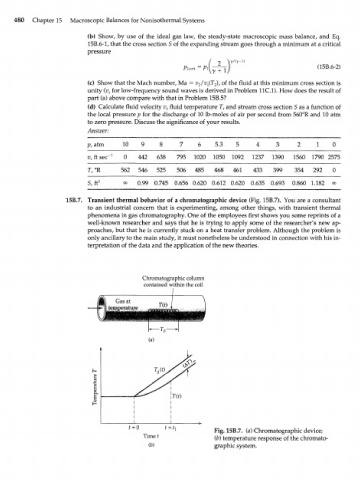Page 500 - Bird R.B. Transport phenomena
P. 500
480 Chapter 15 Macroscopic Balances for Nonisothermal Systems
(b) Show, by use of the ideal gas law, the steady-state macroscopic mass balance, and Eq.
15B.6-1, that the cross section S of the expanding stream goes through a minimum at a critical
pressure
^ ^ J (15B.6-2)
(c) Show that the Mach number, Ma = v 2/v 5(T 2), of the fluid at this minimum cross section is
unity (v 5 for low-frequency sound waves is derived in Problem 11C.1). How does the result of
part (a) above compare with that in Problem 15B.5?
(d) Calculate fluid velocity v, fluid temperature T, and stream cross section S as a function of
the local pressure p for the discharge of 10 Ib-moles of air per second from 560°R and 10 atm
to zero pressure. Discuss the significance of your results.
Answer:
v> atm 10 9 8 7 6 5.3 5 4 3 2 1 0
v, ft sec" 1 0 442 638 795 1020 1050 1092 1237 1390 1560 1790 2575
T, °R 562 546 525 506 485 468 461 433 399 354 292 0
s, ft 2 00 0.99 0.745 0.656 0.620 0.612 0.620 0.635 0.693 0.860 1.182 00
15B.7. Transient thermal behavior of a chromatographic device (Fig. 15B.7). You are a consultant
to an industrial concern that is experimenting, among other things, with transient thermal
phenomena in gas chromatography. One of the employees first shows you some reprints of a
well-known researcher and says that he is trying to apply some of the researcher's new ap-
proaches, but that he is currently stuck on a heat transfer problem. Although the problem is
only ancillary to the main study, it must nonetheless be understood in connection with his in-
terpretation of the data and the application of the new theories.
Chromatographic column
contained within the coil
(a)
Fig. 15B.7. (a) Chromatographic device;
(b) temperature response of the chromato-
graphic system.

